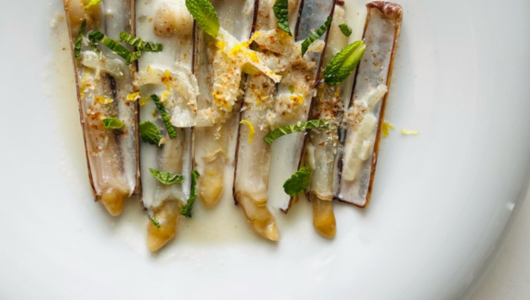Unusual seafood you should try in Lisbon this Summer
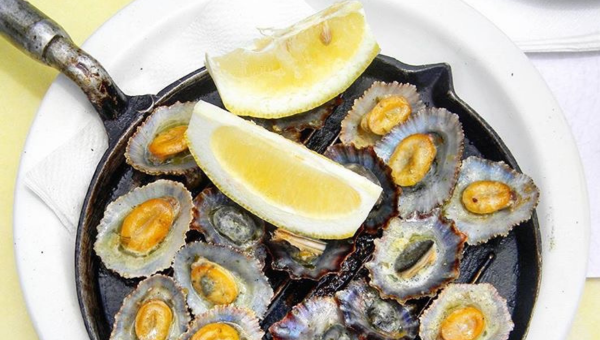
Indulging in fresh seafood is on the bucket list of many travelers who come to Lisbon and who have a keen interest in food culture. It’s understandable – our Atlantic coast is long and the amazing products we get to extract from it are some of Portuguese cuisine’s greatest delicacies.
The best seafood restaurants in Lisbon will serve crowd pleasers such as crab, lobster, shrimp and prawns. But, when you come to look into it, there’s so much more you can try when you visit a Portuguese seafood restaurant, aka Cervejaria. We fear that, oftentimes, folks just don’t end up ordering more unusual options, either because they’re simply not aware of them or there’s a little bit of fear of the unknown that creeps in when you sit down to eat.
With this straightforward guide to some of Portugal’s more atypical seafood options, we hope to shed some light on delicious seafood we hope you get a little more acquainted with and actually get to try when you travel to Lisbon.
Búzios | periwinkles

The world of shells isn’t certainly limited to more popular species such as mussels, oysters and clams. Here in Portugal, we also enjoy periwinkles, known locally as búzios. Just like we eat land snails, periwinkles can be enjoyed as an appetizer or a simple snack with a drink, and eating them one by one as you remove the flesh from inside the shell with a little hook can be fun.
But if you’re not up for the task, ask for a salad instead. Salada de buzios is a very summery recipe featuring the boiled seafood already removed from the shells, and served chilled with thinly chopped vegetables like onions, garlic, tomatoes and assorted pickles, dressed with olive oil and something tangy like vinegar or lemon juice. If you’d rather taste periwinkles warm, ask for búzios à portuguesa, featuring them boiled in water flavored with olive oil, onions, oregano, chili and bay leaf, and lightly seasoned with salt, pepper and fresh parsley.
Lingueirão| razor clams
Portugal loves lingueirão, that is razor clams, also known as grooved razor shells, in all its shapes and forms. We can go for them simply steamed, on the grill, or with buttery and lemony Bulhão Pato sauce with fresh coriander, which we normally eat the most with clams. Razor clams are also an excellent seafood to prepare loose brothy rices similar to seafood rice but, in this case, using only this one species of seafood, therefore being called arroz de lingueirão.
Flavor wise, this bivalve manages to stand out from other species mentioned here, as it has a rather peculiar profile. It’s slightly sweet, nutty and, when cooked right, it’s pretty buttery too. You will easily come across razor clams in Lisbon’s seafood restaurants, even though they usually come from the south of the country, most commonly from Ria Formosa in the Algarve. Have them as an appetizer or as a star ingredient in a main meal, and enjoy!
Cracas | barnacles

Not to be mistaken with gooseneck barnacles which we talk about below, cracas are simply barnacles, and even though sometimes you can find them in the Portuguese mainland, they are far more common in our archipelago of the Azores. Around Lisbon, you may find these barnacles in restaurants specializing in the cuisine from the Azores, but they are not something you should expect to always be available. When they are, though, we would highly encourage you to try them out. When served with a plate of barnacles the restaurant will also give you a little pick which you should take with your hands and use to remove the flesh from inside the shell. The kitchen staff would have already cracked the shell for you so that this process is more seamless and intuitive.
Cracas are usually eaten at room temperature, after having been boiled. Oftentimes, the cooking is done with sea water to enhance their briny flavor. Simple ingredients may be added to make the taste richer, but you wouldn’t want something too overpowering. We’re talking about vegetables such as onions, garlic, fresh parsley and, sometimes, a subtle touch of chili.
Lapas | limpets
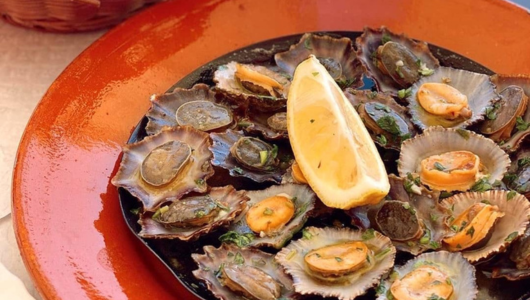
Limpets are the quintessential seafood from our archipelagos, both Madeira and Azores. To have good lapas here in Lisbon, we would surely recommend hitting a Madeiran or Azorean restaurant.
Grilled limpets are a true delicacy. The meat is firm enough yet not chewy, and it’s enhanced by the copious amounts of butter that is usually served melted over the lapas after they’ve come out of the grill. Just before you dig in, squeeze a little lemon, and let the richness, tanginess and compelling sweetness of this seafood take your palate on a trip to the middle of the Atlantic ocean. Some places also serve raw limpets (lapas cruas) which may be a bit more of an acquired taste, but if you like raw oysters, chances are you’d also like these. If not, for another warm option of limpet, we would recommend arroz de lapas, which is a rich and unctuous rice dish enriched with these shells. This is the kind of delicacy which you must try when coming to Lisbon, so that the islands of the Azores and Madeira end up featuring on your travel plans next – they are so good that, chances are, this is indeed what will end up happening!
Percebes | gooseneck barnacles

If there is one so-called bizarre food of Portugal tourists have probably already heard about, that is gooseneck barnacles. Not to be mistaken with simply barnacles (cracas) above, percebes are a staple of Portuguese seafood restaurants and one that we would probably indulge in more often if they weren’t so pricey. They are expensive for good reason though: those who make a living collecting gooseneck barnacles simply risk their lives every time they do it. These creatures grow attached to rocky areas that the furious waves of the ocean keep clashing against. As such, to collect them, you’re not diving, but you’re not exactly above water either. It’s an extremely tough job and that’s why a small to medium serving at a restaurant can easily go for 25 or 30 euros.
Percebes are usually eaten steamed – you’ll see them in Portuguese menus listed as ao natural. Extracting the little morsel of meat that hides inside the Jurassic finger looking creature require a certain level of skill: to remove the skin you ought to crack the head, pull it away from its body and, if everything went well, the portion of meat hiding inside would then be uncovered an ready for you to dig in and to enjoy the flavor of the ocean inside your mouth. This is what gooseneck barnacles taste like – like brine, like the ocean, like a refreshing day out at the beach. It’s quite an experience.
Cavacos e bruxas | slipper lobster

Technically, cavacos and bruxas are different species, but they do have lots in common. Cavacos, also known as santiagos, are Mediterranean slipper lobsters, that is, a smaller cousin of the more commonly praised lobster, yet with equally succulent and flavorful meat. Its smaller counterpart, the bruxas, cavaco-anão or santiaguinhos, are basically the same, yet in smaller size.
Cavacos and bruxas are seasonal and fairly rare. The bigger Mediterranean slipper lobsters are more commonly found in the Azores islands and only sometimes, if you truly get lucky, you’ll come across them in restaurants in the mainland – so, if you do, don’t miss out on the opportunity to taste them. The smaller bruxas, on the other hand, are more readily available around the Portuguese capital, namely in seafood restaurants in Lisbon and particularly Cascais, where it’s common to serve them steamed or fried, with mayonnaise for dipping.
Conquilhas or cadelinhas | donax clams
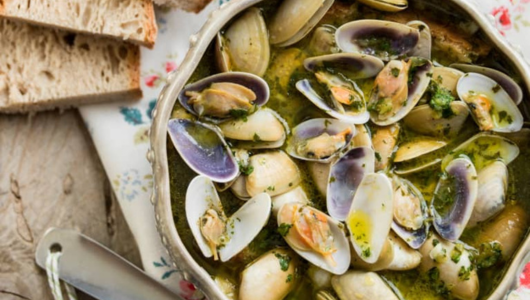
Portugal sure loves its clams. They are an essential ingredient of some of Portugal’s most iconic dishes, such as carne de porco à Alentejana, Alentejo style fried pork with clams, the beloved tangy clams appetizer amêijoas à Bulhão Pato (follow our very own recipe here) and even southern specialities like xerém de amêijoas, through which you can clearly taste the influence the Moors have had in Portuguese cooking.
Conquilhas, also known as cadelinhas, are donax clams or bean clams, and they are way rarer than the regular clams used for the dishes we mention above. Donax clams originate in the coasts of the Algarve and the Alentejo, but you can also find them in Lisbon’s restaurants. They taste fairly mild and sweet and can be used in preparations which make them shine on their own, such as with Bulhão Pato sauce or in xerém de conquilhas, a typical Algarvian corn porridge with clams. Even if you don’t look for conquilhas as such, chances are you may end up eating them anyway, as they are often featured in mixed seafood portuguese dishes such as seafood rice (arroz de marisco), where all sorts of shells, such as for example also cockles (berbigão), end up coming together in the pot to enrich the broth and enhance the overall dish.
Carabineiros | scarlet prawns

If you like prawns, you will love carabineiros, that is, scarlet prawns. Carabineiros are huge and will make you eat with your eyes even before you get to taste their immense depth of flavor. Like a good prawn, carabineiros are sweet, delicate and have an extremely pleasing meaty texture that makes them taste good both steamed, grilled, as well as a part of more elaborate dishes such as cataplana, rice based dishes (arroz de carabineiro) or as a part of a fancy (meaning expensive) version of seafood rice.
You can eat scarlet prawns when you visit some of Lisbon’s most renowned marisqueiras, that is, seafood houses, but also in more inventive dishes in some of the most reputed local restaurants, some of them run by Michelin starred chefs. Chef José Avillez, for example, has popularized a dish of carabineiro with curry prepared with the head of the prawn, while at Henrique Sá Pessoa’s award-winning restaurant ALMA you can also taste scarlet prawn with sea lettuce.
Navalheira | velvet crab
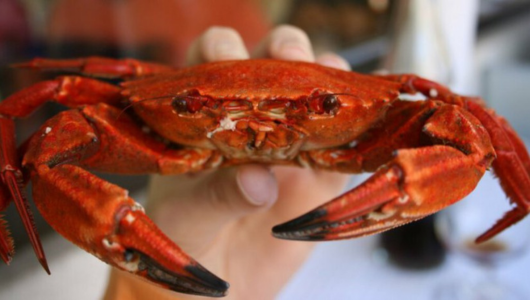
You probably know crab as a general term. When referring to crab here in Portugal without specifying what exact species we are referring to, we are probably talking about sapateira, that is, brown crab. Santola, or spider crab, is also fairly common in Portuguese seafood restaurants, and the most common way of eating it involves the legs and pinchers steamed, while the core is turned into a pâté with the shredded crab meat, mayonnaise, mustard, whisky and an assortment of condiments according to the chef’s preferences.
Navalheira, or velvet crab, is a less common type of crab. This tiny crab is usually caught in tidal pools along the Portuguese coast and, because it’s small in size, it’s usually more affordable than the options we write about above. This doesn’t translate into a lack of flavor, though. If you are willing to use your hands and mouth skillfully and with no fear of making a little mess, you can work your way around a navalheira to try and extract the most meat possible. It’s not an easy task but, if you are up for it, you will be rewarded with morsels of extremely flavorful crab meat, which are honestly very easy to like as they are mild and pleasantly textured.
Camarão da costa | deep-water rose shrimp
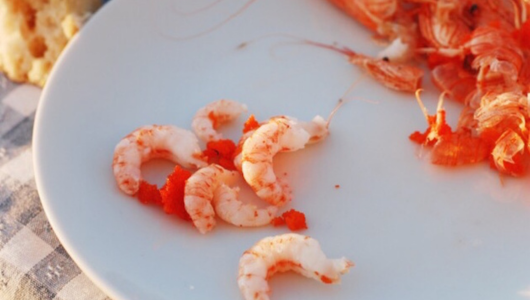
Some countries like to munch on peanuts as they down rounds of beer. Here in Portugal, particularly during warmer months and specifically at cervejarias (that is, beer and seafood focused establishments), we prefer to work our way around plates full of camarão da costa.
Deep-water rose shrimp are tiny and eating them involves a little bit of work, as you need to remove the head and skin before you get to taste their sweet and briny flesh. Perhaps this is why we mostly eat them as a snack, even mid afternoon, when you’re peckish enough but not overly hungry, when taking this much time for the amount of meat you get to enjoy back would probably result in a little frustration. While in Lisbon, to snack on camarão da costa with charming old school vibes, we recommend hopping on a boat to the south bank of the river and choosing one of the restaurants in Cacilhas near the dock itself, where you’ll often see middle aged men sitting a the counter, drinking beers and peeling away rose shrimp as the afternoon welcomes the evening in.
Which of the above seafoods has caught your attention the most? Let us know via Instagram and we can recommend where you can go to try it here in Lisbon. Please tag us @tasteoflisboa #tasteoflisboa
Feed your curiosity on Portuguese food culture:
The best contemporary taverns in Lisbon
Arrábida travel guide for food lovers
The best seafood restaurants in Lisbon
Real people, real food. Come with us to where the locals go.
Signup for our natively curated food & cultural experiences.
Follow us for more at Instagram, Twitter e Youtube

